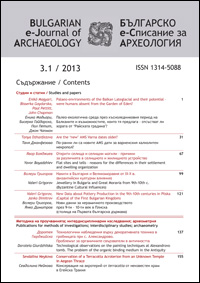Conservation of a Terracotta Acroterion from an Unknown Temple in Aegean Thrace
Conservation of a Terracotta Acroterion from an Unknown Temple in Aegean Thrace
Author(s): Sevdalina NeykovaSubject(s): Archaeology
Published by: Асоциация на българските археолози
Keywords: Acroterion; Artemis; X-Ray Fluorescence Spectrometry; polychromy; Aegean Thrace;
Summary/Abstract: The terracotta acroterion from the permanent exhibition of the National Archaeological Museum in Sofia most probably represents the goddess Artemis. Discovered during the World War I, the acroterion is connected with the past of the ancient city of Dicaea, situated on Lake Bistonis, present-day Lake Vistonida in Greece. Although being a part of the permanent exhibition of the museum, the acroterion needed a new conservation treatment because of the inappropriate intervention applied to it in the past. The aesthetics of the statue were poor and the iron armature inserted into a cavern inside the statue no longer functioned as a system that should hold the statue’s separate parts together. Executed at the Laboratory of Analysis, Conservation and Restoration of the National Institute of Archaeology with Museum, the new conservation treatment aimed not only to return statue’s aesthetics and stability but also to answer to the question whether the acroterion had a polychrome finish as was often the case with statues and terracotta figurines in the Antiquity. The executed chemical аnalyses by meanings of X-Ray Fluorescence Spectrometry (XRF) revealed that the surface of the statue was entirely covered by white paint, obtained by the use of the mineral kaolin. Covering statues with white paint in ancient Greece aimed to make sculptures appear more valuable by eliciting associations with marble. This particular technique refers to Marbleizing or Graining.
Journal: Българско е-Списание за Археология
- Issue Year: 3/2013
- Issue No: 1
- Page Range: 155-160
- Page Count: 6
- Language: English

